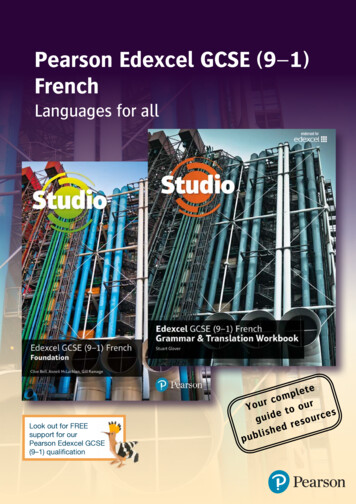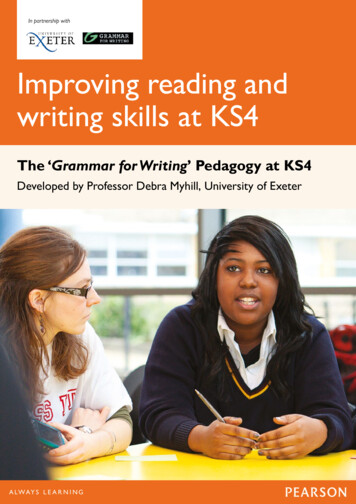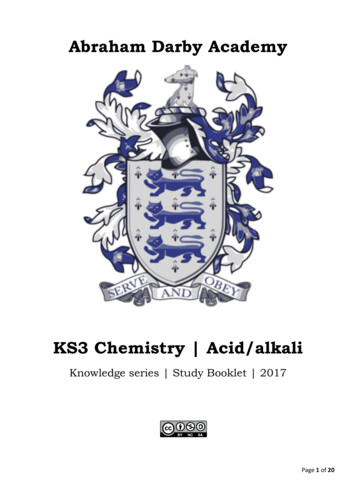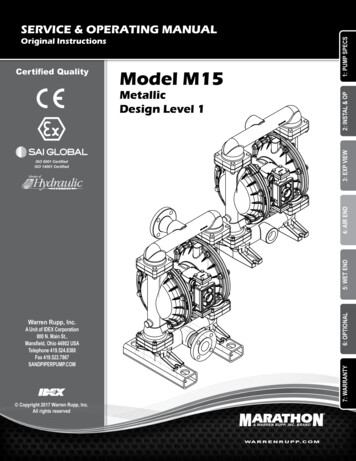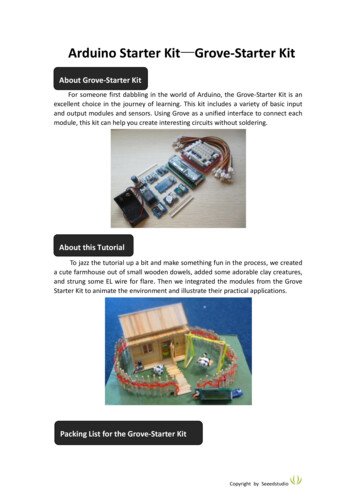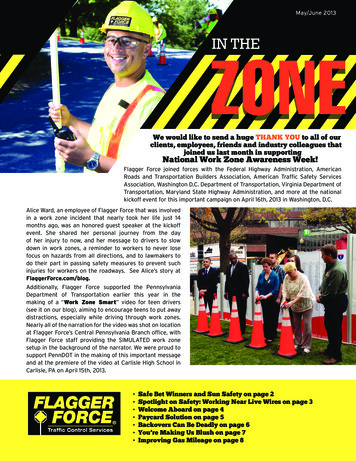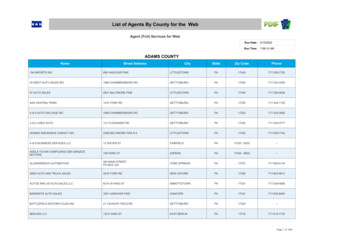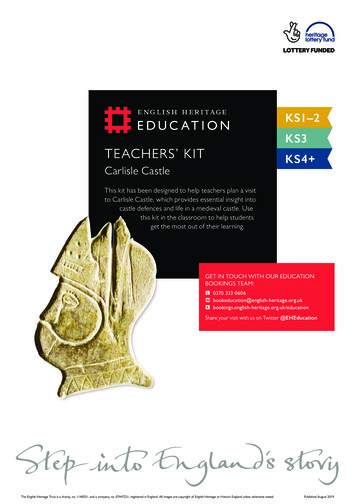
Transcription
KS1-2KS1–2KS3TEACHERS’ KITKS4 Carlisle CastleThis kit has been designed to help teachers plan a visitto Carlisle Castle, which provides essential insight intocastle defences and life in a medieval castle. Usethis kit in the classroom to help studentsget the most out of their learning.GET IN TOUCH WITH OUR EDUCATIONBOOKINGS TEAM:0370 333 english-heritage.org.uk/educationShare your visit with us on Twitter @EHEducationThe English Heritage Trust is a charity, no. 1140351, and a company, no. 07447221, registered in England. All images are copyright of English Heritage or Historic England unless otherwise stated.Published August 2019
WELCOMEThis Teachers’ Kit for Carlisle Castle has been designed for teachers and group leaders to support a free self-led visitto the site. It includes a variety of materials suited to teaching a wide range of subjects and key stages, with practicalinformation, activities for use on site and ideas to support follow up learning.We know that each class and study group is different, so we have collated our resources into one pack allowing youto decide what materials are best suited to your needs. Please use the contents page, which has been colour codedto help you easily locate what you need and download individual sections. All of our activities have clear guidanceon the intended use for study so you can adapt them for your desired learning outcomes.To further aid your planning, we have created Hazard Information sheets, which you can download from theCarlisle Castle Schools page. Here you can also download information on our expert-led Discovery Visits and anoverview of what your class can experience.We hope you enjoy your visit and find this Teachers’ Kit useful. If you have any queries please don’t hesitate to getin touch with a member of our team either via bookeducation@english-heritage.org.uk or on 0370 333 0606.English Heritage Learning TeamICON KEYThe icons below will help you quickly identify the types of activities and information presented.KS1–2LOOKKS3KS4 WRITERE ADE X AMINEMATHSCARLISLE CASTLEROLE PL AYARTCHALLENGEDID YOUKNOW?GROUPACTIVIT -castle/schools2 OF 66
CONTENTSKS1–2KS3KS4 INTRODUCTIONAll the practical things you need to know to plan your visit to Carlisle Castle.Site Information5Site Plan7PRE-VISITInformation and activities you can use in the classroom before your visit.Historical Information9–16Glossary17–19Timeline20–25Why Build Near the Border?26–29Kinmont Willie: a True Story?30–31AT THE CASTLEActivities for students to do at Carlisle Castle to help them get the most out of their learningTop Things To See33–41Survive the Siege42Spy for the Scots43Building for Strength45Activity Trail46–52POST-VISITActivities and information to help extend your students’ learning back in the classroom.SourcesCARLISLE ces/carlisle-castle/schools3 OF 66
INTRODUCTIONAll the practical things you need to know to plan your visitto Carlisle Castle.CARLISLE lisle-castle/schools4 OF 66
BACK TOCONTENTSCARLISLE CASTLESITE INFORMATION98236 7E541KEY TO SITEFACILITIESToilets Accessible toilets also available1 Outer gatehouseand entrance6 Toilets2 Half-moon battery8 Powder Magazine3 Captain’s TowerShop9 Alma Block and Cumbria’sMuseum of Military LifeEducation room4 Keep7 Militia storeE ExhibitionTicket office5 Inner ward wall walkwayFREE PLANNING VISITTo help you plan your trip and see the proper ty in advance, we offer a free planning visit forthose leading a learning group.To take advantage of this, simply print your Booking Permit and take it along to the proper tyfor free entry. Please ensure that you have checked the opening times of the proper ty beforeyou visit.OPENING HOURS FOR EDUCATION VISITORSFor information about opening times, please LISLE lisle-castle/schools5 OF 66
PARKINGThere is no parking for coaches or minibuses at the castle, but there is a drop off point acrossthe road, next to Tullie House Museum. Visitors can then access the underpass or trafficcrossing to the castle. There is coach parking in the local car parks 200 metres from the castle.SHOPA gift shop is available selling a wide range of English Heritage gifts and souvenirs – frombooks and dressing-up clothes, to jewellery and tapestries.GUIDEBOOKSYou can obtain 20% off site guidebooks when you present your visit permit on site.LUNCHThere is no café on-site however, you will find a vending machine selling hot drinks. You canalso purchase a selection of snacks including crisps, cold drinks, confectionery and ice creamfrom the gift shop. Picnics are welcome in the grounds.STORAGEUnfor tunately there are no facilities available.WET WEATHERThis castle is predominately undercover and there is a bookable education room available.ACCESSIBILITYThere are male, female and accessible toilets on-site.Wheelchair access is limited. The new exhibition and grounds are accessible. However, theshop, keep, rampar ts and Captain’s Tower are not wheelchair accessible.Parking for disabled visitors only is located in the Outer Ward of the castle.There is a central paved walkway through to the Inner Ward and then to the keep. To accessthe other sections of the Inner Ward, visitors must cross the cobbles.Please see the website for more information on access le-castle/plan-your-visit/accessBEHAVIOUR & SUPERVISIONWhilst at the proper ty, please ensure that your students are supervised at all times.Please follow these leader-to-student ratios: Years 1 and 2 (ages 5 to 7), 1 leader for every 6 students (1:6) Years 3 to 5 (ages 7 to 10), 1 leader for every 8 students (1:8) Years 6 and over (ages 10 to 18), 1 leader for every 15 students (1:15) for an adult learning group, there are no ratios but there must be an appointed places/carlisle-castle/schools6 OF 66
BACK TOCONTENTSCARLISLE CASTLESITE PLANCARLISLE lisle-castle/schools7 OF 66
PRE-VISITInformation and activities you can use in theclassroom before your visit.CARLISLE lisle-castle/schools8 OF 66
BACK TOCONTENTSHISTORICALINFORMATIONDISCOVER THE STORY OFCARLISLE CASTLEBelow is a short history of Carlisle Castle.Use this information to learn how the site haschanged over time. You will find definitions ofthe key words in the Glossary.AD c.100–410: ROMAN BEGINNINGSIn AD c.100, a large Roman fort was built where the castlestands today. In AD c.122, the Emperor Hadrian ordered thebuilding of a defensive wall across the north of England thatmarked the boundary of the Roman empire in Britain. Thefort supported soldiers on the wall and actedas a staging post for Roman armies invading Scotland.A town called Luguvalium grew up around the fort toprovide services to the soldiers. Luguvalium becameprosperous and the Romans stayed here until the endof the fourth century AD.Once the Romans left Britain, around AD 410, nativeBritons probably lived at the site of the fort for thenext 100 years.CARLISLE CASTLEThis part of a Roman altar is fromthe third century AD. In the late14th century, it was recycled inthe outer gatehouse to prop upa door lisle-castle/schools9 OF 66
NORMAN BORDER CONTROLFollowing the Battle of Hastings in 1066, the Normansconquered England. By 1092, King William Rufus (r.1087–1100) wanted to claim the land between England andScotland that was still fought over by the Normans,Vikings, Saxons and Scots. At this time, Carlisle was ruledby a man named Dolfin, who probably supported the Scots.King William Rufus arrived in Carlisle, drove out Dolfin andbuilt a castle. We don’t know exactly where this strongholdwas, but it was likely to be near where the castle is today.It was probably an earth ringwork with wooden buildingsinside. This type of fort was easy, cheap and quick to build,and William needed to build a castle urgently in case theScottish armies tried to take Carlisle.Norman castles were often firstbuilt quickly using earth andwood, and then later re-built instone to make them more secure.In 1122, King Henry I (r.1100–35) visited Carlisle andordered that it be ‘fortified with a castle and towers’.Work on the keep began.In 1135, when Henry I died, England fell into civil war.King David of Scotland (r.1124–53) took Carlisle Castlewhile the rest of the country was distracted by the war.David probably finished the stone castle that Henry I hadbegun. Building in stone took many years!In the 12th century, the stonekeep was built to make the castlestronger during an attack andeasier to rlisle-castle/schools10 OF 66
A SCOTTISH SIEGE –NO SURRENDER!When Henry II (r.1154–89) took the throneof England in 1154, the threat of his powerwas so great that the Scots left Carlisle.The English returned, and Henry orderedthe castle buildings to be reorganisedand strengthened. He built new outerand inner gatehouses.The earliest parts of the innergatehouse are from the 12th century.The stronger stone castle was tested between 1173 and1174 when the Scottish King William ‘the Lion’ (r.1165–1214) attacked Carlisle twice,with a large army. The castle and city came under siege and were close to surrenderwhen William was defeated by the English forces at the Battle of Alnwick.Henry visited Carlisle in 1186 and ordered improvements, including a new chamberfor him with a small tower and a decorated chapel with expensive glass windows.KING ALEXANDER’S SUCCESSFUL SIEGEHenry II’s son, King John (r.1199–1216), stayed at Carlislefour times and spent a lot of money on improving thecastle. King John was facing opposition from the baronsin the north of England and used Carlisle as one of thebases from which to control them. The barons decidedto rebel against the king in 1215, and made an alliancewith the Scottish king, Alexander II (r.1214–49). In 1216,Alexander went to take Carlisle for himself and the peoplein the city surrendered – but the soldiers at the castlerefused. It was attacked and put under siege – the southcurtain wall was sapped by miners and both gatehouseswere badly damaged by shells. Eventually, the castle wascaptured by the Scots. When King John died, theyleft Carlisle.A portrait from c.1620, by anunknown artist, of King John.John used Carlisle Castle as abase to rule the north of Englandbut in 1216 it was captured byAlexander II of Scotland.When the Treaty of York was signed in 1237, a newborder was created between England and Scotland. This meant that the castlewas not needed to defend against attacks and was left abandoned. Twenty yearslater, a report claimed the castle was ‘very greatly in need of ces/carlisle-castle/schools11 OF 66
1314:A SCOTTISH ATTACKKing Edward I (r.1272–1307) used CarlisleCastle as the main base for defendingnorthern England from the Scots and tolaunch his attacks on Scotland.In 1314, the Scottish army defeated theEnglish at the Battle of Bannockburnand soon afterwards, led by Scottish KingRobert the Bruce (r.1306–29), theyattacked Carlisle. They used a siegeA siege tower used in a modernre-enactment at Kenilworth Castle.engine to try to attack from outside theIn the siege of Carlisle in 1314, theScots’ siege tower got stuck incity wall, just below the castle. But thethe mud.English army, led by the sheriff Sir AndrewHarclay, and the townspeople were ready– the city and castle walls were lined with engines for firing projectiles. What reallyhelped the English, though, was the rain. It had rained so heavily that the moat outsidethe city walls was impossible to cross; the ground was so muddy that when the Scotswheeled their siege tower towards the walls it got stuck! The Scots tried to mineunder the walls but the ground would quickly fill with water when they dug.After 11 days, the Scottish army left Carlisle without capturing the city or castle.Eight years later, Sir Andrew Harclay was arrested for treason at the castle.King Edward was displeased that Sir Andrew had made a new peace deal withthe Scots without his permission. He ordered that Sir Andrew be hung, drawnand quartered (some of his insides removed and his body cut into four parts),and one of his ‘quarters’ left on top of the castle isle-castle/schools12 OF 66
FIRST GUNS AT THE CASTLEThe war with Scotland continued into the late 1300s.Between 1370 and 1380, the Scots attacked the north ofEngland more frequently. To make the castle stronger, theouter gatehouse was rebuilt for cannons to be brought in.Two cannons were put on top of the keep – the highestpoint in the castle with the best view of approachingattackers. These guns were made of brass and fired ballsof stone or iron using gunpowder. These were a very earlyexample of explosive artillery.The outer gatehouse was rebuiltThe people who supervised the border on behalf of thefrom 1378 to 1383 to hold largecannons – a new type of artillery.king of England were called the Wardens of theMarches. In the 14th, 15th and 16th centuries, Carlisle wasthe home of the Wardens of the West March. The wardens were usually powerful lordswho were experienced soldiers. The kings and March Wardens in the 15th century didnot spend much money at Carlisle and the castle was left to ruin.TUDOR UPGRADESIn 1529, a report described the castle as being close tocollapse. It wasn’t until it was attacked by rebels opposed toKing Henry VIII (r.1509–47), as part of the Pilgrimage ofGrace in 1536–37, that repairs were made. Henry also fearedthat the Scots might make an alliance with the French (asthey both opposed his divorce from Catherine of Aragonand his break from the Roman Catholic Church) and thatthey would try to invade northern England.In 1541, German military engineer Stephan vonHaschenperg began to design the defensive improvementsat Carlisle. He needed to make sure that the castle couldhold new, heavy artillery and also stand up to fire fromthe enemy’s guns. So he built buttresses outside thecurtain wall, the half-moon battery and made thewall-walk and the roof of the keep stronger. But Stephanworked too slowly and was fired in 1543. By then, Henrywas less worried about an attack from Scotland.Henry VIII upgraded the defencesat the castle in the 1540s becausehe feared an attack by the Scots,supported by the French.The half-moon bat terywasbuilt in the 1540s so handguand cannon could be use nsd todefend the inner isle-castle/schools13 OF 66
KINMONT WILLIE’S ESCAPEThe castle was kept in service as a base for keeping watch onthe border lands and as a prison for cattle thieves. In 1596,William Armstrong of Kinmont, or ‘Kinmont Willie’, afamous Border Reiver who was being kept prisoner at thecastle, was helped to escape by his fellow Reivers. The storyof his escape is told in ‘The Ballad of Kinmont Willie’ butmisses out the key facts that Kinmont Willie was not chaineddown in a dungeon but held in a room in the outer ward, andthat he and his rescuers had help from inside the castle.1600s: SIEGEThe notorious Border ReiverWilliam ‘Kinmont Willie’Armstrong was helpedtoescape from Carlisle Castleon 13 March 1596. Cumbria Image BankOF STARVATIONIn 1617, when King James I (r.1603–25) returned toEngland from Scotland, he stayed at Carlisle Castle.The castle had been neglected, but James did not repairit. When James had been crowned king of England andScotland in 1603, the two countries were united as onekingdom so the castle was no longer needed to defendthe border.Things changed during the English Civil War whenCharles I (r.1625–49) was king. The castle was preparedfor attack from the Parliamentarian army with threegun batteries set up in the inner and outer wards.In the 17th century, Charles Iprepared the castle for attackfrom Parliamentarians by addingnew gun batteries.In 1644, the Parliamentarian victory at the Battle ofMarston Moor meant that most of northern England was controlled by Parliamentand the Scots. Later that year, Carlisle came under siege by the Scots once again.The city was surrounded by cannons and earthworks. Rather than attack the cityand castle directly, the Scots waited to starve the people out, not letting anyone in orout of the city gates. The people in the city became so hungry that they were forcedto eat their horses, dogs and, later, even rats. Eventually, after eight months, the citysurrendered.When the monarchy was restored, Carlisle Castle once again belonged to the Crown.Very little money was spent on it and by the end of the 1600s the garrison had isle-castle/schools14 OF 66
JACOBITE REBELLIONIn 1745, Carlisle was underprepared for the Jacobiterebellion, led by Charles Edward Stuart or ‘BonniePrince Charlie’. Colonel James Durand commanded a forceof just 1,250 men against around 5,000 Scots. Although thegovernment sent English soldiers to help, they were trappedby snow and unable to reach the city. On 9 November, theJacobite army arrived and some of the Colonel’s men beganto desert (leave without permission). Eventually the Colonelwas forced to surrender. Charles Edward Stuart was ledinto the city by 100 Scottish pipers.of CharlesA portrait from c.1750e ’, byturedcapllysfucessucesarlChlish.the castle from the EngOn 20 December, the Scottish army retreated back across theborder, leaving 400 men to defend the castle and city against theadvancing English army, led by the Duke of Cumberland. Thecity was surrounded and the castle was bombarded with siegeguns and mortars. On 30 December, the Jacobites surrendered.Following the English victory at the Battle of Culloden,captured Jacobite soldiers were held prisoner at Carlisle Castle.Thirty-one were hanged and the rest were transported toNorth America. After that, life at the castle was quiet againand it was used as a military store.19th-CENTURYA historical re-enactmentof Colonel Durand’s forcesdefending Carlisle Castleduring the 1745 siege.BARRACKSIn 1819, soldiers returned to Carlisle Castleonce again. The city’s textile workers werecampaigning for political and social reform,and the Government decided to turn thecastle into a barracks so that soldierswould be there permanently to stop anydisturbances or violent protests. Newbuildings were put up to house the troops andsome of the older buildings converted.New barrack s were built for soldiers whocame to live permanently at Carlisle Castle inthe early 19th century.From the 1870s, the castle was used as a recruitment and training centre for the newlycreated Border Regiment. By the end of the century, the castle was appreciated more andmore as a tourist s/carlisle-castle/schools15 OF 66
CARLISLE CASTLE IN THE FIRST WORLD WARIn 1911, the War Office agreed with the Office of Works to share responsibilityfor the castle buildings. During the First World War, the castle was mainly used totrain recruits and as a depot for the Border Regiment. There was a military hospitalin the outer ward. A total of 23,000 recruits passed through the castle during theFirst World War. These recruits probablyhelped with digging for the Office ofWorks’ excavation of the ditchesaround the half-moon battery.The tarmac-covered parade ground inthe outer ward is where much of thetraining took place. Gravel was laid ontop of the grassed areas to make thespace larger. The brick buildings aroundthe parade ground were built in the 19thand 20th centuries to house hundredsof soldiers.the 19th- andThe buildings were named afterBorder Regimentthehwhicin20th-century battlesMilitary Life,oftook part . Cumbria’s MuseumCarlisle Castle.The castle also provided a headquarters for the Volunteer Training Corps andaccommodation for the Labour Corps during the war. Outside of the castle, this‘total war’ was fought in different ways in factories and hospitals. Many of Carlisle’slocal women worked in munitions factories and all types of buildings were used asmakeshift war hospitals where nurses cared for the wounded.The Border Regiment served inalmost every major area of conflict ofthe war; France and Flanders, Italy,Mesopotamia, Gallipoli and Macedonia.7,000 soldiers from the Border Regimentlost their lives. The Regiment won manyBattle Honours, including the VictoriaCross five times. You can discovermore about the history of the BorderRegiment at Carlisle Castle by visitingCumbria’s Museum of Military LifeAn inspection of the Volunteer Training Corps atCarlisle Castle in c.1917. Cumbria’s Museum ofMilitary Life, Carlisle Castle.inside the castle grounds and exploringtheir website: reachIn 1959, the regimental depot moved out of the castle, though most of the buildingsin the outer ward were still used by the military, and are still in use lisle-castle/schools16 OF 66
BACK TOCONTENTSGLOSSARYTRICKY TERMS ANDWHAT THEY MEANBelow is a list of words you might comeacross while exploring Carlisle Castle.Use this Glossary to find out whatthey mean.artillery – large guns (cannons) used in war on landbaron – the lowest-ranking member of the British nobility (aristocracy or ‘upper classes’)barracks – a large building or group of buildings used to house soldiersBattle of Alnwick – the battle in Northumberland on 13 July 1174 when William I ofScotland (r.1165–1214), also known as William the Lion, was captured by English forcesBattle of Bannockburn – the battle near Stirling on 23–24 June, 1314, betweenRobert the Bruce and Edward II (r.1307–27), which was an important Scottish victory in theFirst War of Scottish Independence Battle of Culloden – the final battle of theJacobite rising on 16 April 1746, near Inverness, inwhich the Duke of Cumberland defeated CharlesEdward Stuart and ended his claim to the Englishand Scottish thronesBattle of Marston Moor – one of the major battlesof the English Civil War, in which the Parliamentarian defeat ofthe Royalists on 2 July 1644 near York signified the end of theirpower in the north of EnglandA cannon from the 18th centuryon the walkway at Carlisle Castle.The walkway was originallywidened in the 16th century tosupport new, larger artillery.Kindly on loan from the Royal Armouries.Border Regiment – one of the oldest units of the BritishArmy, it was formed under this title in 1881 by combining the34th Cumberland and 55th Westmorland RegimentsBorder Reivers – lawless people who raided others’property along the Anglo-Scottish border, taking cattle andsupplies, from the late 13th century to the beginning of the17th centuryCARLISLE lisle-castle/schools17 OF 66
garrison – a group of troops living in afortress or town to defend itgatehouse – a room(s) built over a castleentrance, which were used for living in, andsometimes as prisonsgun batteries – a strong shelter orsupporting structure built to protect or holdartilleryhalf-moon battery – a gun battery inthe shape of a semi-circleIn the 16th century, Henry VIIIordered the castle walls to bestrengthened with huge buttresses.buttress – a narrow piece of wall builtagainst another wall, to strengthen orsupport itchamber – a room or apartmentchapel – a small building or room used forJacobite – a supporter of James II(r.1685–88) (after he was deposed) and hisdescendants, including Charles Edward Stuart,in their claim to the British thronekeep – the strongest tower of a castle andthe final refuge during an attackmonarch – the ruling king and/or queenChristian worship within a larger building,such as a castleCharles Edward Stuart – the eldestson of James Stuart, who was the son ofJames II. Charles attempted to take thethrone of the United Kingdom during thesecond Jacobite revolution; he was alsoknown as ‘Bonnie Prince Charlie’civil war – a war between citizens ofthe same countrydepot– a place for the storage of largequantities of equipment, food or goodsEnglish Civil War – the war from1642 to 1651 between people who supportedParliament (Parliamentarians) and peoplewho supported the King (Royalists) overhow England should be ruledfortified – protected by defensivestructuresThe semi-circular half-moonbattery at Carlisle Castle thatallowed a broader firing rangefor handguns and artillery.mortars – a short gun with a smooth innersurface inside for firing shells at high anglesmunitions – military weapons, ammunition,equipment and lisle-castle/schools18 OF 66
Office of Works – began in the royalhousehold in 1378 to oversee the building ofroyal castles and homes. In 1940 it becamepart of the Ministry of Works, and now manyof the places it cared for are looked after byEnglish HeritageParliamentarian – a supporter ofParliament in the English Civil WarPilgrimage of Grace – a popularTreaty of York – an agreementbetween Henry III of England (r.1216–72) andAlexander II of Scotland (r.1214–49), signed atYork on 25 September 1237, that marked outthe modern Anglo-Scottish borderVictoria Cross– a military decorationawarded for extreme bravery in the armedservices, introduced in 1856, during QueenVictoria’s reignwall-walk – a defensive feature in medievalrising in Yorkshire in October 1536 againstHenry VIII’s (r.1509–1547) break with theRoman Catholic Church, the Dissolution ofthe Monasteries and other political changescastles that allowed soldiers to quickly movebetween towers, keep watch for approachingenemies and use it as a fighting platformprojectiles – an object propelled throughward – an area of ground enclosed by thethe air, especially one thrown or fired asa weaponringwork – circular earth banks andtrenches around a medieval castleRobert the Bruce – King of the Scotsfrom 1306 until his death in 1329sapped – gradually weaken a fortificationby removing its foundationsshell – an explosive artillery projectilesiege – a military operation in which enemyforces surround a town or building, cuttingoff essential supplies, with the aim of forcingthose inside to surrendercastle wallsWarden of the March – a positionin the governments of Scotland and England.The wardens were responsible for the securityof the border between the two countries, andoften took part in military actionWar Office – a department of theBritish Government responsible for theadministration of the British Army between1857 and 1964William Armstrong of Kinmont– a Border Reiver and outlaw active in theAnglo-Scottish border country at the endof the 16th centurysiege engine – a device that is designedto break or overcome castle or city walls,towers or any fort structure during a siegesiege tower – a wooden tower on wheels,which could be pushed up to the wall of acastle during a siege to allow the attackersto reach the top of the wallstaging post – a place at which peopleor vehicles regularly stop when making aparticular journeyA typical medieval siegetowa re- enactment at Kenilw er used duringorth rlisle-castle/schools19 OF 66
EVENTS IN BRITISH HISTORYROMAN BRITAINAD 43–410MEDIEVAL BRITAINROMANSNORMANS1066-11541066- C .1500AD 431066The Romans arrive toconqueror Britain.William the Conqueror is victorious atthe Battle of Hastings. The NormanConquest of England begins.AD 122–1281086Emperor Hadrian buildsa wall to defend northernRoman-occupied Britainfrom invasion by Pict tribes.Domesday Book is completed.AD 4101087The Romans leave Britain.CARLISLE CASTLE THROUGH THE AGESAD 1William dies. His son,William Rufus, iscrowned King William II.1000AD 122–1281092A large Roman fort is builtin Carlisle on the site ofthe current castle.William Rufus drivesDolfin out of Carlisle,builds an earthworkcastle and puts hissoldiers on guard there.1 STCENTURY11 THCENTURY
MEDIEVAL BRITAIN1066- C 54Henry I crowned kingof England.Henry II crowned king of England.1124David I crowned kingof Scotland.1139–53Civil war in Englandbetween King Stephenand Empress Matilda.1174Scottish King William‘the Lion’ is defeated andcaptured by the English atthe Battle of Alnwick.110011571122The Scots leave Carlisle.Henry II orders the castlebuildings to be strengthened.New inner and outergatehouses are built.Henry I visits Carlisle andorders a stone castle tobe built.11351173–74King David of Scotland takesCarlisle from the English andcontinues the building workof the stone castle.Scottish King William ‘the Lion’attacks Carlisle twice, puttingthe castle and city under siege.Before they surrender,William is defeated at theBattle of Alnwick.1186Henry II visits Carlisleand orders a new king’schamber, tower and chapel.12THCENTURY
MEDIEVAL BRITAIN1066- C .1500PLANTAGENETS1154–148512151314King John signs Magna Carta at Runnymede.Soon afterwards, the barons revolt againstthe king, aligning with Alexander, king ofScotland, and Prince Louis of France, to try toremove King John.The English are defeatedby the Scots at the Battleof Bannockburn.1237The Treaty of York meant that the Scotsabandoned their rule of northern England.The Anglo-Scottish border line is drawn.1296War with Scotland begins.1300120012161315Scottish King Alexander II takes the cityof Carlisle. He puts the castle undersiege until it surrenders.The Scottish army, led byKing Robert the Bruce,attacks Carlisle but failsto capture the castle.c.12171323The Scots withdraw from Carlisle.1256Sir And
This Teachers' Kit for Carlisle Castle has been designed for teachers and group leaders to support a free self-led visit to the site. It includes a variety of materials suited to teaching a wide range of subjects and key stages, with practical . with expensive glass windows. r . KING ALEXANDER'S SUCCESSFUL SIEGE : Henry II's son, King .
